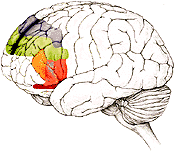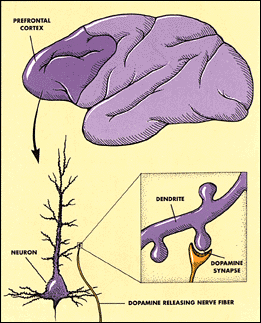



Connections Through Time, Issue 12: July
- September 2001
![]()
 |
|
The prefrontal cortex is vital |
How do we recall and store
information long enough to work with it. Here's a defining quote from a Scientific
American Article:
researchers are beginning to
fathom the neural processes underlying "working memory"--the limited,
short-term store of currently relevant information that we draw on when we
comprehend a sentence, follow a previously decided plan of action or remember a
telephone number. When we bring to mind the name of Russia's president, for
instance, that information is temporarily copied from long-term memory into
working memory.
The prefrontal cortex of the brain appears to be a key part of the nervous
system controlling working memory.
Advanced imaging techniques were first used in 1997 to show the moment-by-moment
brain activity involved in seeing a face or a series of letters, holding it
briefly in working memory, and then recalling it. Two research teams supported
by the National Institute of Mental Health (NIMH) reported on the studies using
functional magnetic resonance imaging (fMRI). These
studies were the first in humans to demonstrate sustained activity in the
prefrontal cortex while information is held in mind.
 Working memory
disorders, such as schizophrenia,
illustrate the importance of the "executive functions" of the
prefrontal cortex which include decision making, attention, and planning.
Researchers believe that the high concentrations of nerve fibers containing
the neurotransmitter dopamine are central to working memory and executive
functions. Neurotransmitters are chemicals which
transmit messages from neuron to neuron via synapses. They act by binding
to molecules called receptors. Monkeys have been used extensively to study
the effects of various chemicals on the brain. The figure at the right
shows the brain of a monkey and the prefrontal cortex. The inset shows a dopamine synapse.
Working memory
disorders, such as schizophrenia,
illustrate the importance of the "executive functions" of the
prefrontal cortex which include decision making, attention, and planning.
Researchers believe that the high concentrations of nerve fibers containing
the neurotransmitter dopamine are central to working memory and executive
functions. Neurotransmitters are chemicals which
transmit messages from neuron to neuron via synapses. They act by binding
to molecules called receptors. Monkeys have been used extensively to study
the effects of various chemicals on the brain. The figure at the right
shows the brain of a monkey and the prefrontal cortex. The inset shows a dopamine synapse.
A May
2001 report from the NIMH discusses a
genetic link between dopamine activity in the prefrontal cortex to working
memory tasks and to a slightly increased risk for schizophrenia:
The finding, which must still be confirmed by independent teams of
investigators, emerged from an ongoing study of people with schizophrenia and
their siblings. The study is among the first to suggest a mechanism by which a
gene might confer susceptibility to a mental illness, say the researchers.
Daniel Weinberger, M.D., Michael Egan, M.D., NIMH Clinical Brain Disorders
Branch, and colleagues, report on their results in the May 29, 2001 Proceedings
of the National Academy of Sciences.
The most disabling form of mental illness, schizophrenia affects one percent
of the adult population, typically in young adulthood, with hallucinations,
delusions, social withdrawal, flattened emotions and loss of social and personal
care skills. Although its cause remains a mystery, evidence suggests that it is
at least 80% heritable, stemming from complex interactions among several genes
and non-genetic influences. Several chromosomal regions have been implicated,
but none have been definitely confirmed and no genes have yet been linked to the
disorder.
Given the syndrome's daunting complexity, Weinberger and colleagues have been
studying many traits to identify those that patients share with their well
siblings, hoping to turn up clues to susceptibility genes. Their brain imaging
studies had revealed that both well siblings and patients falter on tasks of
working memory and show abnormal activation of the prefrontal cortex, which is
required for such "executive" functions. Studies have shown that the
chemical messenger dopamine plays a pivotal role in tuning the activity of the
prefrontal cortex during such tasks.
Executive functions associated
with the
prefrontal cortex and working memory include:
- initiation and overall control of deliberate actions
- initiation and overall control of goal directed behavior
- attention
- planning
- decision making
However, it is crucial to recognize that most of these functions are phenomena
of distributed neural processing and without a unique location of their own,
either in frontal cortex or elsewhere. (Ref.)
The prefrontal cortex is central to organizing the distributed information
contained in the nervous system.
We wonder how this growing body of knowledge concerning our nervous systems
relate to how the subconscious mind accesses and communicates intuitive
information to the conscious mind. The prefrontal cortex is probably involved with
this communication process. Intuitive information and the mind are
discussed in the next
section.
References
The
Machinery of Thought, Scientific American Article, Aug 1997
fMRI Reveals
Dynamics of Working Memory, National Institute of Mental Health Press
Release, April, 1997
The
Prefrontal Cortex and Schizophrenia, Brain Briefings, Summer 1995
Go to another section of this
issue:
Intuition: "It's All in Your
Mind" Applications:
An Online Protocol for Exploring Your Intuition
![]()